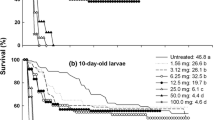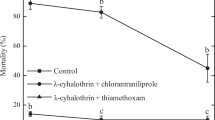Abstract
A diet-incorporation larval bioassay was used to evaluate the response of the leafroller Pandemis heparana (Denis and Schiffermüller) to seven insecticides: tebufenozide (Mimic 23% a.i., Bayer), methoxyfenozide (Prodigy 23% a.i., Bayer), flufenoxuron (Cascade 50 DC 4.7% a.i., BASF), lufenuron (Match 5.32% a.i., Syngenta), indoxacarb (Steward WG 30% a.i., Du Pont), abamectine (Vertimec EC 1.9% a.i., Syngenta) and spinosad (Laser 44.2% a.i., Dow Agro Science). Both neonate and 12-day-old (third to fourth instar) larvae were used in the bioassay. The obtained efficacy baselines were compared with the response of the pest exposed to leaves treated with the same insecticides. The persistence of field-aged leaf residues of the seven insecticides was bioassayed on neonate larvae. Given the obtained LC50 values in the diet-incorporation bioassays larval age was not always a significant factor affecting the response of P. heparana larvae. Differences in LC50 values between neonate and 12-day-old larvae were not statistically significant for abamectine, tebufenozide and methoxyfenozide. Young larvae seemed to be more susceptible than older larvae to spinosad, indoxacarb and lufenuron, while flufenoxuron was more effective against 12-day-old than neonate larvae. When the larvae were exposed to the insecticides on treated leaves, all the tested compounds were less effective on older larvae than on neonates. When applied at the recommended field rates, all seven insecticides can be considered highly effective against both neonate and 12-day-old larvae of P. heparana because their security index (SI = recommended field rate/LC90) always exceeded the threshold value of 1. The high persistence of insect growth inhibitors (IGIs) and moulting accelerating compounds (MACs) in the field compensates for their relatively low SI values. For this reason and given their activity against Cydia pomonella, IGIs and MACs are the most interesting insecticides for spring treatments for the combined control of both species, P. heparana and C. pomonella.
Similar content being viewed by others
References
Abbott WS (1925) A method of computing the effectiveness of an insecticide. J Econ Entomol 18:265–267
Charmillot PJ, Pasquier D (1995) Le lufénuron, un nouveau produit sélectif pour lutter au printemps contre les tordeuses de la pelure, les noctuelles et les arpenteuses. Revue Suisse Vitic Arboric Hortic 27(2):129–133
Charmillot PJ, Pasquier D, Schneider D (1991) Efficacité ovicide et larvicide de 3 inhibiteurs de croissance d’insectes (ICI) sur la tordeuse de la pelure Adoxophyes orana F.v.R. J Appl Ent 112:327–334
Charmillot PJ, Paquier D, Alipaz NJ (1994) Le tébufenozide, un nouveau produit sélectif de la lutte contre le carpocapse Cydia pomonella L. et la tordeuse de la pelure Adoxophyes orana F.v.R. Revue Suisse Vitic Arboric Hortic 26(2):123–129
Charmillot PJ, Gourmelon A, Fabre AL, Pasquier D (2001) Ovicidal and larvicidal effectiveness of several insect growth inhibitors and regulators on the codling moth Cydia pomonella L. (Lep., Tortricidae). J Appl Ent 125:147–153
Charmillot PJ, Pasquier D, Verneau S (2004) Efficacité larvicide de differents insecticides incorporés au milieu artificel d’elevage sur les vers de la grappe. Revue Suisse Vitic Arboric Hortic 36(3):141–145
Cossentine JE, Jensen LB (1991) Monitoring azinphos-methyl resistance in Archips agyrospila (Lepidoptera:Tortricidae) populations. J Econ Entomol 84(5):1399–1403
Dickler E (1991) Tortricid Pests of Pome and stone fruits, Euroasian species. In: van der Geest LPS and Evenhuis HH (eds). Tortricids Pests, their biology, natural enemies and control. Elsevier, Amsterdam, pp 435–452
Forti D, Angeli G, Ioriatti C (2003) Codling moth: state of art on traditional and innovative control strategies. Informatore Fitopatologico 53(5):13–16
Ioriatti C, Forti D, Delaiti M (1991) Insect growth regulators (I.G.R.): evaluation of the spray application period for Adoxophyes orana (F. v. R.), Archips podana (Sc.) and Pandemis heparana (D. & S.). Informatore Fitopatologico 12:32–36
Ioriatti C, Delaiti M, Angeli G, Mattedi L (1993) Laboratory study and field verification of the activity of 3 I.G.R. on some leafrollers species (A. orana F.v.R., A. podana Sc., P. heparana D. et S. P. cerasana Hb.) present in the apple orchards of Trentino region (Italy).Informatore Fitopatologico 10:45–49
Knight A, Hull L, Rajotte E, Hogmire H, Horton D, Polk D, Walgenbach J, Weires R, Whalon J (1990) Monitoring azinphos methyl resistance in adult male Platynota idaeusalis (Lepidoptera:Tortricidae) in apple from Georgia to New York. J Econ Entomol 83(2):329–334
Pons S, Riedl H, Availla J (1999) Toxicity of the ecdisone agonist tebufenozide to codling moth (Lepidoptera: Tortricidae). J Econ Entomol 92(6):1344–1351
Regiroli G, Manaresi M (1997) Lack of cross-resistance between diflubenzuron and tebufenozide on Cydia pomonella in strains from Alto Adige/South Tyrol (Italy). Informatore Fitopatologico 5:60–62
Reissig WH, Stanley BH, Hebding HE (1986) Azinphos–methyl resistance and weight-related response of obliquebanded leafroller (Lepidoptera: Tortricidae) larvae to insecticides. J Econ Entomol 78:692–699
Robertson JL, Priesler JC (1992) Pesticide bioassays with arthropods. CRC, Boca Raton
Rodriguez LM, Reagan TE, Ottea JA (2001) Susceptibility of Duatraea saccharalis (Lepidoptera: Crambidae) to Tebufenozide. J Econ Entomol 94(6):1464–1470
Sauphanor B, Brosse V, Monier C, Bouvier JC (1998) Differential ovicidal and larvicidal resistance to benzoylureas in the codling moth, Cydia pomonella. Ent Exp Appl 88(3):247–253
Suckling DM, Rogers DJ, Shaw PW, Wearing DR, Penman R, Chapman RB (1987) Monitoring azinphos–methyl resistance in the light brown apple moth (Lepidoptera: Tortricidae) in New Zealand. J Econ Entomol 80:733–738
Vilajeliu M, Padilla D, Batllori JL (1999) Effect of some insecticides on Pandemis heparana, leafroller of pome fruit. IOBC/WPRS Bull 22(7):183–188
Waldstein DE, Reissig WH, Scott JC, Straub RW (1999) Susceptibility of obiquebanded leafroller (Lepidoptera: Tortricidae) populations from commercial apple orchards and an unsprayed habitat in New York to tebufenozide. J Econ Entomol 92(6):1251–1255
Acknowledgments
The authors are much indebted to P. J. Charmillot (Agroscope RAC Changins) for the fruitful discussion and the critical review of the article.
Author information
Authors and Affiliations
Corresponding author
Additional information
Communicated by Heidrun Vogt
Rights and permissions
About this article
Cite this article
Ioriatti, C., Pasqualini, E., Pasquier, D. et al. Efficacy baselines of seven insecticides against larvae of Pandemis heparana (Lepidoptera: Tortricidae). J Pest Sci 79, 163–168 (2006). https://doi.org/10.1007/s10340-006-0130-0
Received:
Revised:
Accepted:
Published:
Issue Date:
DOI: https://doi.org/10.1007/s10340-006-0130-0




